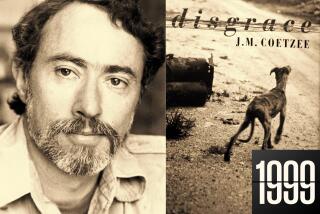Life after terror
- Share via
In the weeks and months after Sept. 11, many Americans were caught in the grip of an unbidden nightmare, trying to fathom the horrific ends of those lost. The victims’ last phone messages or conversations were merely the tip of an iceberg of speculation: What were their final thoughts and actions? And what of those they left behind? How can they live with the reflected horror of their loved ones’ very public demise? And what about the men who undertook these suicide missions? Were they merely deranged terrorists, religious or political zealots who hate America, or were their motivations more complex? And how should we protect ourselves against them?
Although news media rushed to provide many answers, we are just beginning to see the fruits of more creative imaginations seeking their own versions of resolution. Pete Hamill’s novel “Forever” touched on the subject through his historical portrait of New York, and now there is Janette Turner Hospital’s ambitious, literary thriller “Due Preparations for the Plague,” which, although it revolves around a fictional 1987 Air France hijacking, addresses the motives and methods of those who plan and carry out such atrocities and, more important, those who survive them and those who do not.
Principal among the survivors in Hospital’s novel is Lowell Hawthorne, a hapless 29-year-old house painter and estranged husband and father of two who is crippled by anniversary grief associated with Air France 64, which claimed the life of his mother and hundreds of others. As the novel opens, Lowell is on a job while listening to NPR, teetering literally and figuratively under the weight of his recurring thoughts about that day 13 years before. “Death, he hears, and it is plummeting at him, no question, final cure of all diseases. The news commentator says these words .... Have the words really come from the radio? Or from the very messy attic of his mind?” Among Lowell’s real-life tormentors is Samantha Raleigh, who was a 6-year-old survivor of the Air France flight. Released unexpectedly by the terrorists while her parents and infant brother remained on the doomed plane, Samantha is obsessed with the fate of the passengers who died when the plane was blown up after landing in Iraq. Were they all killed or, as was rumored, were some taken to another place before the explosion? Are they still alive? These questions have plagued Samantha, transforming the little girl into a bitter, unruly college student who pores over undeleted half lines in government documents declassified under the Freedom of Information Act. It is here that she is introduced to the shadowy figure of Sirocco, a possible terrorist who, she is convinced, “lit the fuse,” and to the equally mysterious agent or double agent code named Salamander, who seems to hold the key to the why and how of Air France 64. Like Lowell, Samantha hears voices, but they are the voices of those who conspired to make and unmake her particular brand of hellish existence, most notably Salamander, whom she never meets but with whom she is engaged in a symbiotic dance.
But unlike Lowell, whose grief has estranged him from his wife and children, Samantha and other child survivors have banded together as the Phoenix Club, a support-cum-conspiracy theory group with a Web site that attracts others consumed by the hijacking and the myriad theories surrounding the fate of its passengers.
Through the Internet, Samantha learns that a Frenchwoman named Francoise, who claims to be Lowell’s half-sister, believes Lowell’s father may have information. But it is too late to ask Mather Hawthorne, a retired intelligence officer, to explain; he recently died in a car crash after having a massive coronary. When the senior Hawthorne’s psychiatrist surfaces in Boston with a package of tapes and notebooks that Mather left for Lowell, the unstable young man is unwittingly sucked into a cesspool of plots, counterplots and machinations worthy of a John Le Carre or Len Deighton.
Using multiple viewpoints, the novel moves deftly among the young survivors, the adult victims, the terrorists and those who try to manipulate them for their own and the nation’s sometimes questionable interests. For, as the slippery Salamander asserts, intelligence agents are “making the world safe for moral systems....[e]xactly which system or order we sustain ... is immaterial. We support the system most likely to stay in place.”
For all the political intrigue and pronouncements the author injects in the novel, she clearly intends to whet the appetites of thriller fans while nourishing literary readers by liberally seasoning “Due Preparations for the Plague” with allusions to Boccaccio’s 14th century masterpiece “Decameron” and quotes from Daniel Defoe, Albert Camus and others.
Yet, it is Hospital’s ability to read the hearts and minds of her characters, their petty jealousies and obsessions that makes the novel compelling and allows it to rise above some loose ends in the plot and a somewhat forced denouement. These small annoyances aside, Hospital has wrought from tragedy a life-affirming tale, asking in the end, as Samantha does, a highly personal question that arises from public tragedy: “[H]ow do we ready ourselves for what might happen tomorrow? What possible preparations can be made?”
More to Read
Sign up for our Book Club newsletter
Get the latest news, events and more from the Los Angeles Times Book Club, and help us get L.A. reading and talking.
You may occasionally receive promotional content from the Los Angeles Times.








